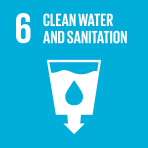- Home
- Sustainable Development Goals
- Clean Water and Sanitation
 Clean Water and Sanitation
Clean Water and Sanitation
Preface
The third progress report under the Convention on the Protection and Use of Transboundary Watercourses and International Lakes (Water Convention) was prepared by the Convention secretariat in line with decision VIII/1 of the Meeting of the Parties to the Convention. In that decision the Parties requested the secretariat to prepare regular reports on the implementation of the Convention based on the national reports received.
Glossary of key terms
Access to safe drinking water and sanitation. Safe and clean drinking-water and sanitation is a human right. The term safe refers to drinkingwater and sanitation services that protect health. This can be ensured via connections to public networks and services or through decentralized solutions.
Acknowledgements
The Water Convention secretariat is grateful to all the Parties to the Convention for their considerable efforts in the completion of their national reports for the third reporting exercise.
Executive summary
Transboundary waters are of great significance globally. An estimated 313 rivers and lakes and 468 aquifers are shared by two or more countries and a total of 153 UN Member States are reliant on waters that either flow from or flow to another country (see figure i).
Presenting the UN-Water Integrated Monitoring Initiative for SDG 6
Through the UN-Water Integrated Monitoring Initiative for SDG 6 (IMI-SDG6) the United Nations seeks to support countries in monitoring water- and sanitation-related issues within the framework of the 2030 Agenda for Sustainable Development and in compiling country data to report on global progress towards SDG 6.
Industry and energy
It is a paradox that industry and energy are both perpetrators and victims of climate change in mountain areas and the cryosphere.
Résumé
Dans le sillage du choix de l’année 2025 comme Année internationale de la préservation des glaciers et de l’adoption d’une résolution sur le développement durable dans les régions montagneuses par l’Assemblée générale de l’Organisation des Nations Unies en 2022 le présent rapport vise à rappeler à l’humanité l’importance des eaux de montagne en particulier des glaciers alpins pour le développement durable des régions montagneuses ainsi que pour les sociétés en aval qui en dépendent et ce alors que la cryosphère de montagne subit un bouleversement rapide.
Executive summary
In alignment with the designation of 2025 as the International Year of Glaciers’ Preservation and the 2022 resolution of the General Assembly of the United Nations on sustainable mountain development this report draws worldwide attention to the importance of mountain waters including alpine glaciers in the sustainable development of mountain regions and the downstream societies that depend upon them in the context of the rapidly changing mountain cryosphere.
Renforcement des savoirs et des capacités
Mieux comprendre les principes fondamentaux de l’hydrologie des régions de haute montagne est un impératif pour faciliter la prise de décision.
Knowledge- and capacity-building
The hydrological fundamentals of high mountain regions need to be better understood to support decision-making.
Introduction
Les montagnes dont on dit souvent qu’elles sont les « châteaux d’eau » de la planète tiennent un rôle unique et essentiel dans le cycle de l’eau terrestre. D’une part elles influent sur la circulation atmosphérique qui conditionne les variations climatiques et les régimes de précipitations.
